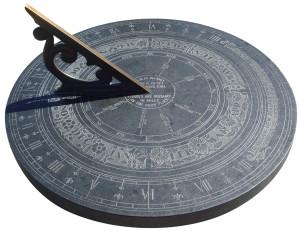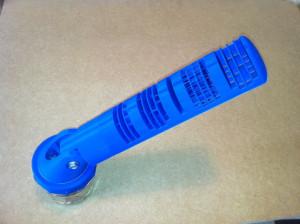Do you remember the first time you grasped the concept of a sundial, the idea that we can tell general time from observing the shadow cast by the sun via an object designed for this purpose? It seemed like a pretty magical concept, and it also introduces basic concepts about math and astronomy in an interesting and beneficial way.
 It was Ancient Egyptian and Babylonian astronomy that gave us the first sundials, and since then they have been used as serious objects of mathematical study and as decorative objects because they represent technology of the past that was streamlined over time. Sundials are rather simple instruments at first glance. Using just a few parts, the trick is to get the edge (style) of the part that throws the shadow (gnomon) to be parallel to the Earth’s rotation axis while staying accurate all year long. For the Southern hemisphere, the latitude has to be reversed from the Northern hemisphere’s latitude. Now, add 3D printing to make a digital sundial for the Southern hemisphere and that might get your attention, right?
It was Ancient Egyptian and Babylonian astronomy that gave us the first sundials, and since then they have been used as serious objects of mathematical study and as decorative objects because they represent technology of the past that was streamlined over time. Sundials are rather simple instruments at first glance. Using just a few parts, the trick is to get the edge (style) of the part that throws the shadow (gnomon) to be parallel to the Earth’s rotation axis while staying accurate all year long. For the Southern hemisphere, the latitude has to be reversed from the Northern hemisphere’s latitude. Now, add 3D printing to make a digital sundial for the Southern hemisphere and that might get your attention, right?
That’s right. Julldozer of Mojoptix set out to 3D print a sundial with the question: “What if we had a sundial that worked more like some sort of enormous digital watch?” And what he means by this is that as the style on the sundial moves, sun is either blocked or it breaks through the design holes (he calls it “swiss cheese”) so that the actual time can be read in the shadow of the sundial.
 Wow. And I thought I had heard it all. It’s kind of like, why stop at approximating the correct time with a sundial when you can straight out just have the exact digital time displayed? Modern enough for you yet?
Wow. And I thought I had heard it all. It’s kind of like, why stop at approximating the correct time with a sundial when you can straight out just have the exact digital time displayed? Modern enough for you yet?
In a YouTube video (see below) that explains how Julldozer conceptualized and designed the project, he tells us he built the sundial algorhythmically using OpenSCAD. He created a matrix for each number shown on the sundial. Then he combined these number matrixes into an open-source 3D printable model with OpenSCAD script and STL files. The whole project is open source, and you can download everything on Thingiverse (or just buy it from his Etsy shop). All you’ll need are four 3D printed parts (ABS, he notes), as well as a jam jar and a few screws, nuts, and washers.
As Julldozer describes, 3D printing proves to be essential in the project because the elaborate algorhythmically designed holes — the “swiss cheese”– can’t be made any other way like injection molding or another mass production method. This makes sense since the design using sunlight cast through holes to show legible numbers is quite an elaborate undertaking.
We are used to hearing that “3D printing is the only way,” and this is another one of those projects. It’s an incredible example of some unthinkably modern ways to retain technologies of the past. Once you understand where to point the tip of the sundial (North or South?), the rest of the project seems accessible, as Julldozer of Mojoptix has done most of the hard work already for the rest of us. Let us know your thoughts on this design in the 3D Printed Sundial forum thread on 3DPB.com.
Subscribe to Our Email Newsletter
Stay up-to-date on all the latest news from the 3D printing industry and receive information and offers from third party vendors.
Print Services
Upload your 3D Models and get them printed quickly and efficiently.
You May Also Like
Reinventing Reindustrialization: Why NAVWAR Project Manager Spencer Koroly Invented a Made-in-America 3D Printer
It has become virtually impossible to regularly follow additive manufacturing (AM) industry news and not stumble across the term “defense industrial base” (DIB), a concept encompassing all the many diverse...
Inside The Barnes Global Advisors’ Vision for a Stronger AM Ecosystem
As additive manufacturing (AM) continues to revolutionize the industrial landscape, Pittsburgh-based consultancy The Barnes Global Advisors (TBGA) is helping shape what that future looks like. As the largest independent AM...
Ruggedized: How USMC Innovation Officer Matt Pine Navigates 3D Printing in the Military
Disclaimer: Matt Pine’s views are not the views of the Department of Defense nor the U.S. Marine Corps Throughout this decade thus far, the military’s adoption of additive manufacturing (AM)...
U.S. Congress Calls Out 3D Printing in Proposal for Commercial Reserve Manufacturing Network
Last week, the U.S. House of Representatives’ Appropriations Committee moved the FY 2026 defense bill forward to the House floor. Included in the legislation is a $131 million proposal for...



































